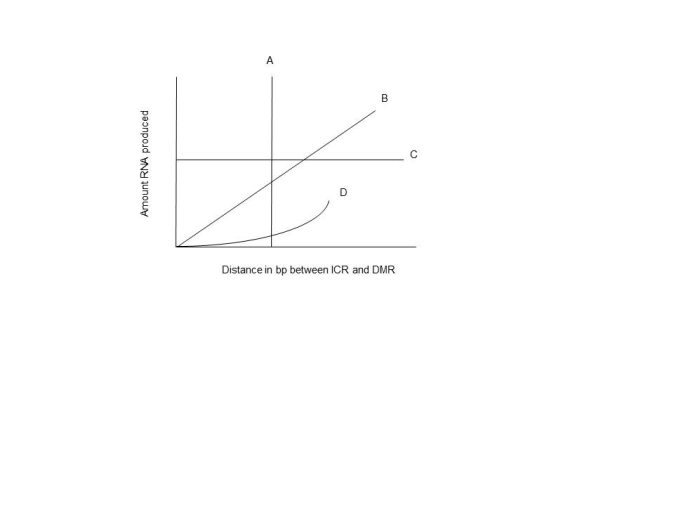A) an increase in ferritin mRNA translation and a decrease in transferrin receptor mRNA stability.
B) a decrease in transferrin receptor mRNA translation and an increase in ferritin mRNA stability.
C) an increase in ferritin and transferrin receptor mRNA translation.
D) an increase in ferritin and transferrin receptor gene transcription.
Correct Answer

verified
Correct Answer
verified
Multiple Choice
The differentially methylated region (DMR) is associated with which of the following?
A) X-inactivation
B) Genomic imprinting
C) Maternal inheritance
D) Extra nuclear inheritance
E) All of the answers are correct
Correct Answer

verified
Correct Answer
verified
Multiple Choice
If a cell is fused with another cell, which of the following would be the best example of a trans-mechanism of epigenetic control?
A) A gene that is originally silenced in one cell but expressed in the other is silenced in the hybrid
B) A gene that is originally silenced in one cell but expressed in the other is still expressed in the hybrid.
C) The methylation pattern of the same gene from either cell is not altered
D) There are no examples that could conform to a trans-mechanism
Correct Answer

verified
Correct Answer
verified
Multiple Choice
In cancer cells one allele of the tumor suppressor gene p53 is frequently mutated so that the protein is inactive, not produced, or deleted. The other allele will usually have a normal sequence and the promoter remains intact but the gene is not expressed. Sequencing with sodium bisulfite modification of DNA can be used to detect which cytosines are methylated. If the cancer cell DNA is sequenced what would be the anticipated results?
A) Cytosines in or near the promoter region will be methylated
B) Cytosines in or near the promoter will not be methylated
C) Cytosines in the coding region will have an increased mehtylation
D) There will be no differences in the methylation pattern of the promoter of p53 from a cancer cell and a normal cell
Correct Answer

verified
Correct Answer
verified
Multiple Choice
How many Barr bodies would an individual with a XXY genotype possess?
A) 0
B) 1
C) 2
D) None of the answers are correct
Correct Answer

verified
Correct Answer
verified
Multiple Choice
In the Igf-2 allele, which chromosome is imprinted? Which is expressed?
A) Paternal, paternal
B) Paternal, maternal
C) Maternal, paternal
D) Maternal, maternal
Correct Answer

verified
Correct Answer
verified
Multiple Choice
It is possible that the effects of the association of the ICR and DMR regions with the CTC factors could be distance dependent. An experimental outline could be devised where the effects of the distances of these regions could be varied and the rates of transcription could be measured. Below is a graph of some possible results. Which letter represents the most likely outcome if an increase in distance between these two regions results in a diminished effect on transcription rates? 
A) A
B) B
C) C
D) D
Correct Answer

verified
Correct Answer
verified
Multiple Choice
Which of the following statements are correct?
A) Changes in gene expression based on environmental conditions are not considered normal while developmental changes are
B) Environmental epigenetic changes can vary due to the exposure of the organism to different environmental conditions, while those programmed during development are the result of stimuli generated by the organism itself
C) Environmental epigenetic gene regulation only occurs in reptiles and insects, while developmental epigenetic regulation occurs in all animals
D) Environmental epigenetic gene regulation is typically reversible while developmental epigenetic gene regulation is typically not reversible.
Correct Answer

verified
Correct Answer
verified
Multiple Choice
What gene is most responsible for X-inactivation?
A) Xic
B) Xist
C) Tsix
D) Xce
Correct Answer

verified
Correct Answer
verified
Multiple Choice
Which of the following is part of the process of X chromosome inactivation?
A) Expression of Xist from both chromosomes at the start of the process
B) Binding of multiple Xist transcripts to Xic on the X chromosome that will be inactivated
C) Compaction of the active X chromosme into a Barr body
D) Binding of Tsix transcripts to the X chromosome to be inactivated after the Xist transcripts binds to Xic
Correct Answer

verified
Correct Answer
verified
Multiple Choice
Which of the following can control mRNA stability?
A) The stop codon that is used to terminate translation in the mRNA
B) AU rich elements in the mRNA
C) distance of the stop codon to the polyA tail
D) number of A's in polyA tail
Correct Answer

verified
Correct Answer
verified
Multiple Choice
The most likely explanation for the phenomenon where a protein may be found in different sub-cellular locations in different cells is
A) stabilization of the mRNA transcript
B) alternative splicing
C) RNA interference
D) transport of mRNA from the nucleus to the cytoplasm
Correct Answer

verified
Correct Answer
verified
Multiple Choice
The Lyon hypothesis attempts to explain the molecular mechanism of _____.
A) X-inactivation
B) Genomic imprinting
C) Maternal inheritance
D) Extra nuclear inheritance
Correct Answer

verified
Correct Answer
verified
Multiple Choice
What is the molecular mechanism for imprinting a gene?
A) Acetylation
B) Nitration
C) Phosphorylation
D) Methylation
Correct Answer

verified
Correct Answer
verified
Multiple Choice
Which of the following are molecular mechanisms used in epigentic gene regulation?
A) DNA methylation
B) Covalent histone modification
C) Chromatin remodeling
D) All are correct
Correct Answer

verified
Correct Answer
verified
Multiple Choice
Which of the following is an example of epigenetic inheritance?
A) Expression of the Igf-2 gene based on methylation of the ICR and DMR regions
B) Inheritance of flower color as studied by Mendel
C) Leaf coloration based on mitochondrial inheritance
D) Snail shell twist patterns
Correct Answer

verified
Correct Answer
verified
Showing 21 - 36 of 36
Related Exams